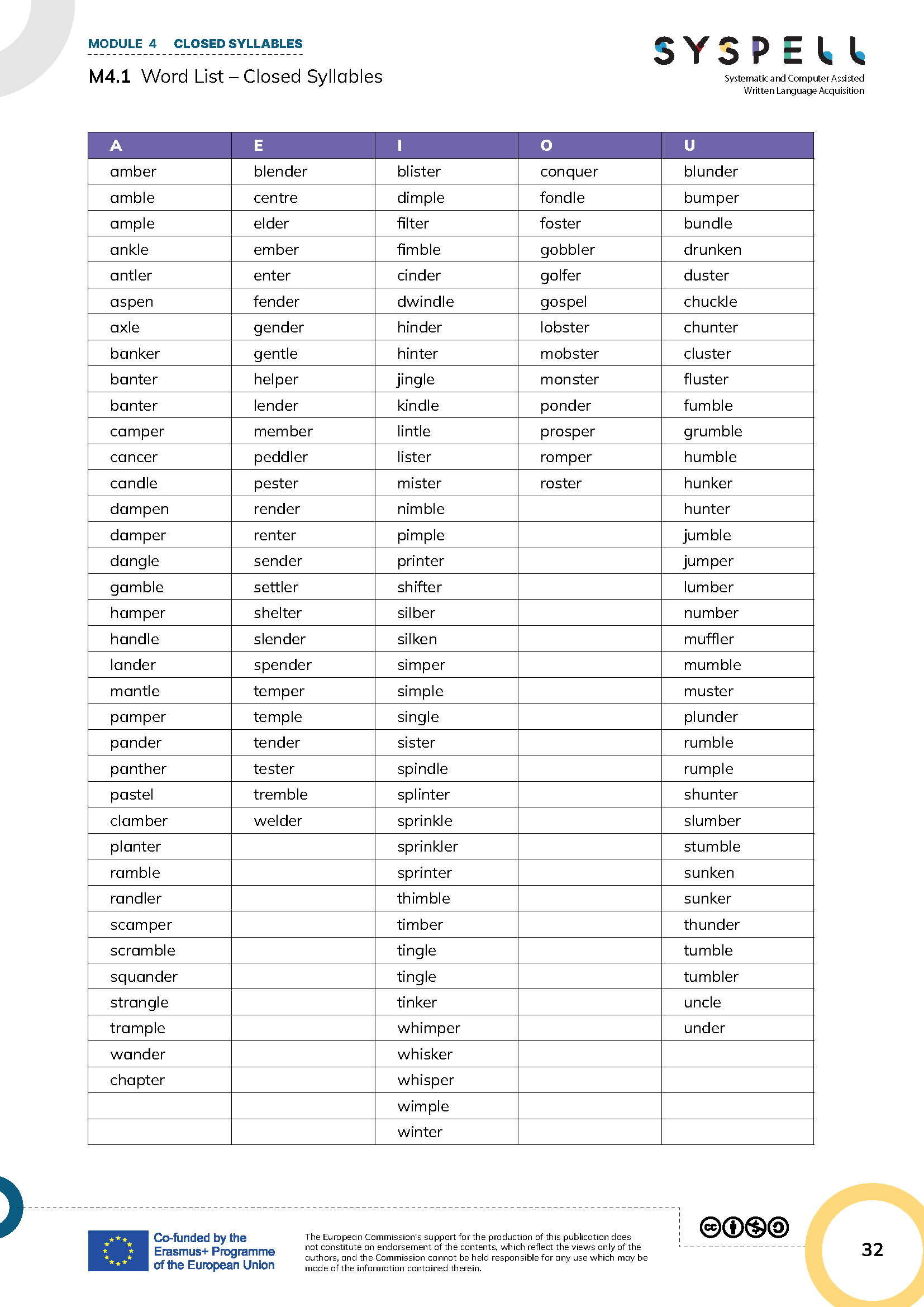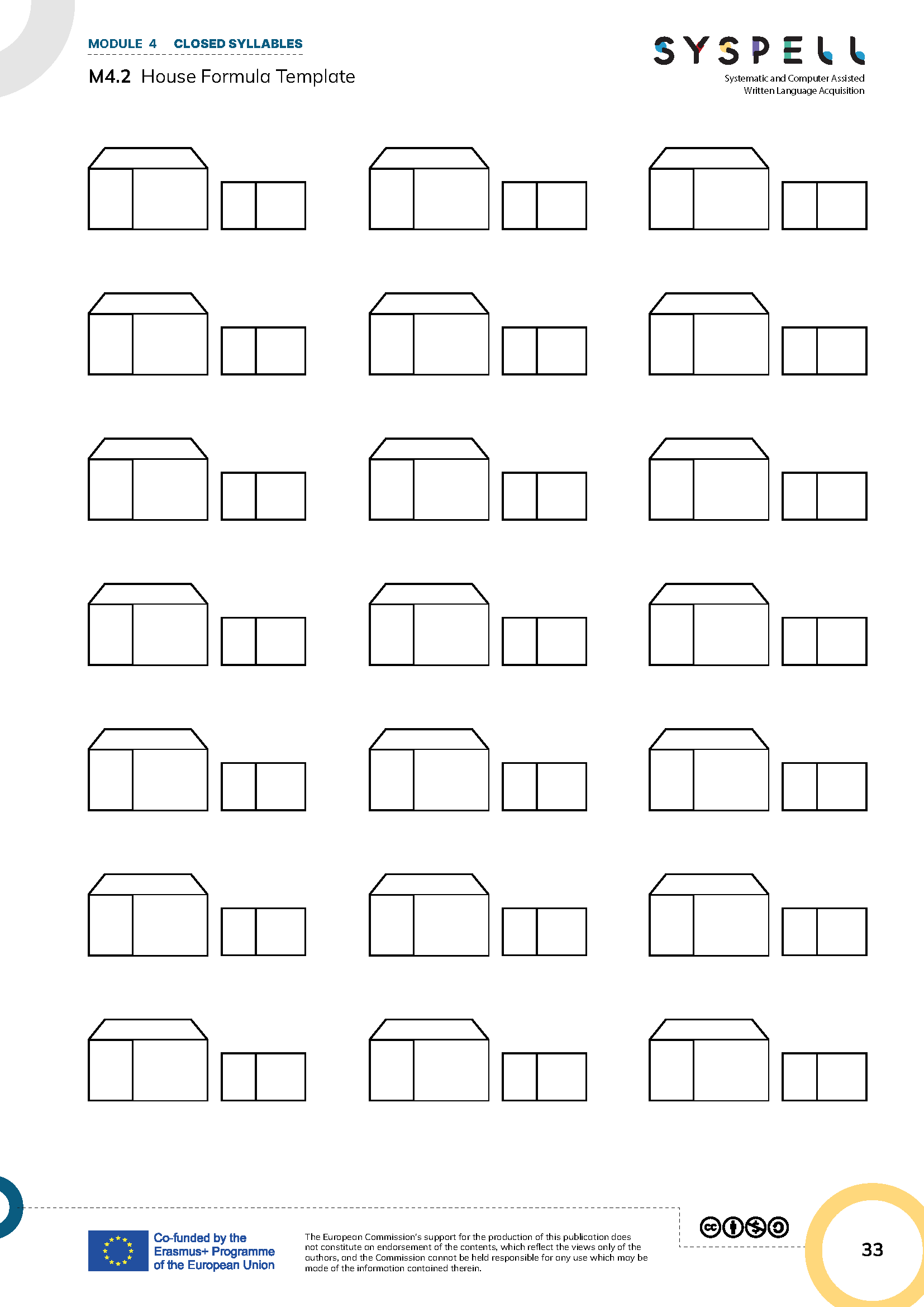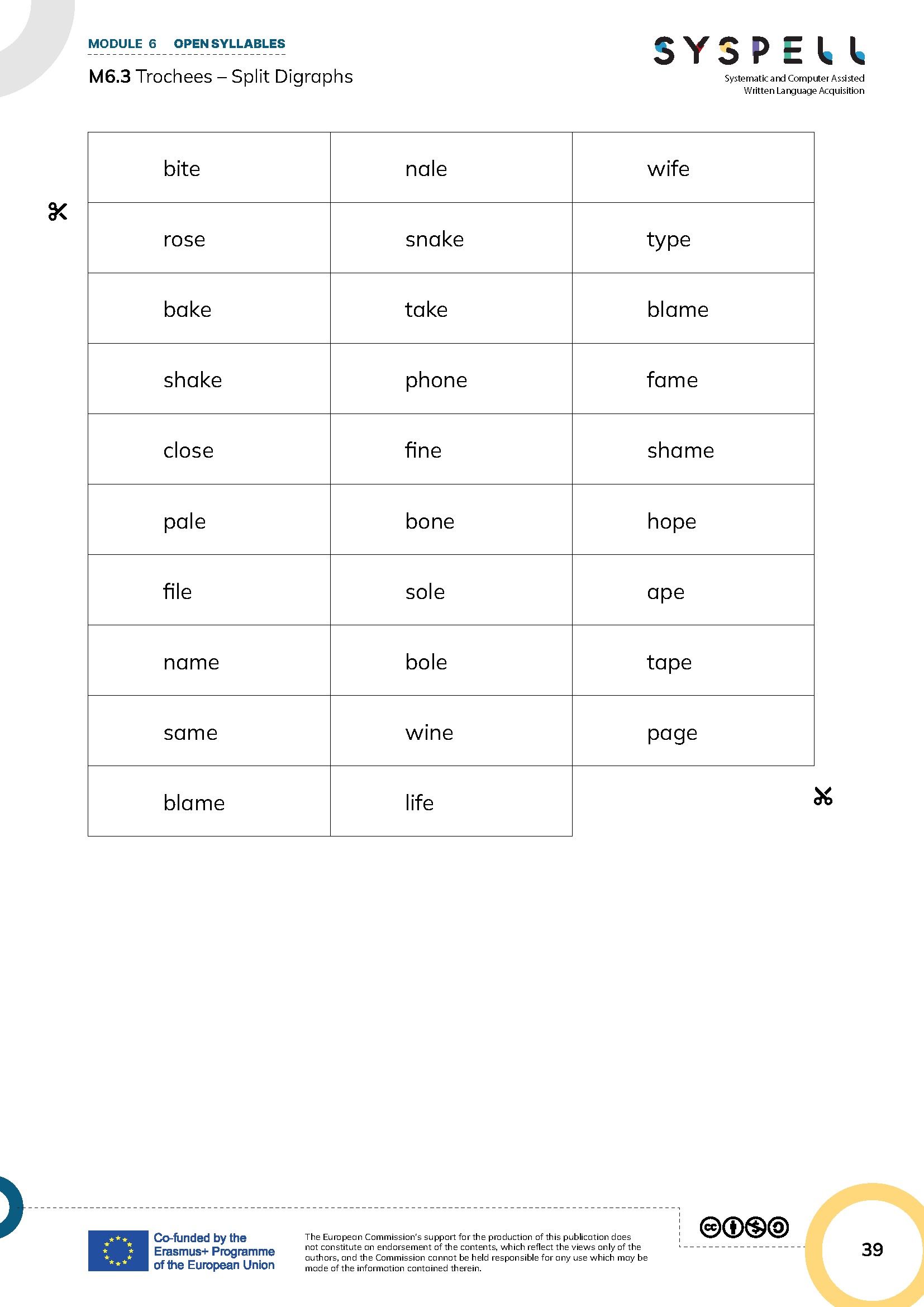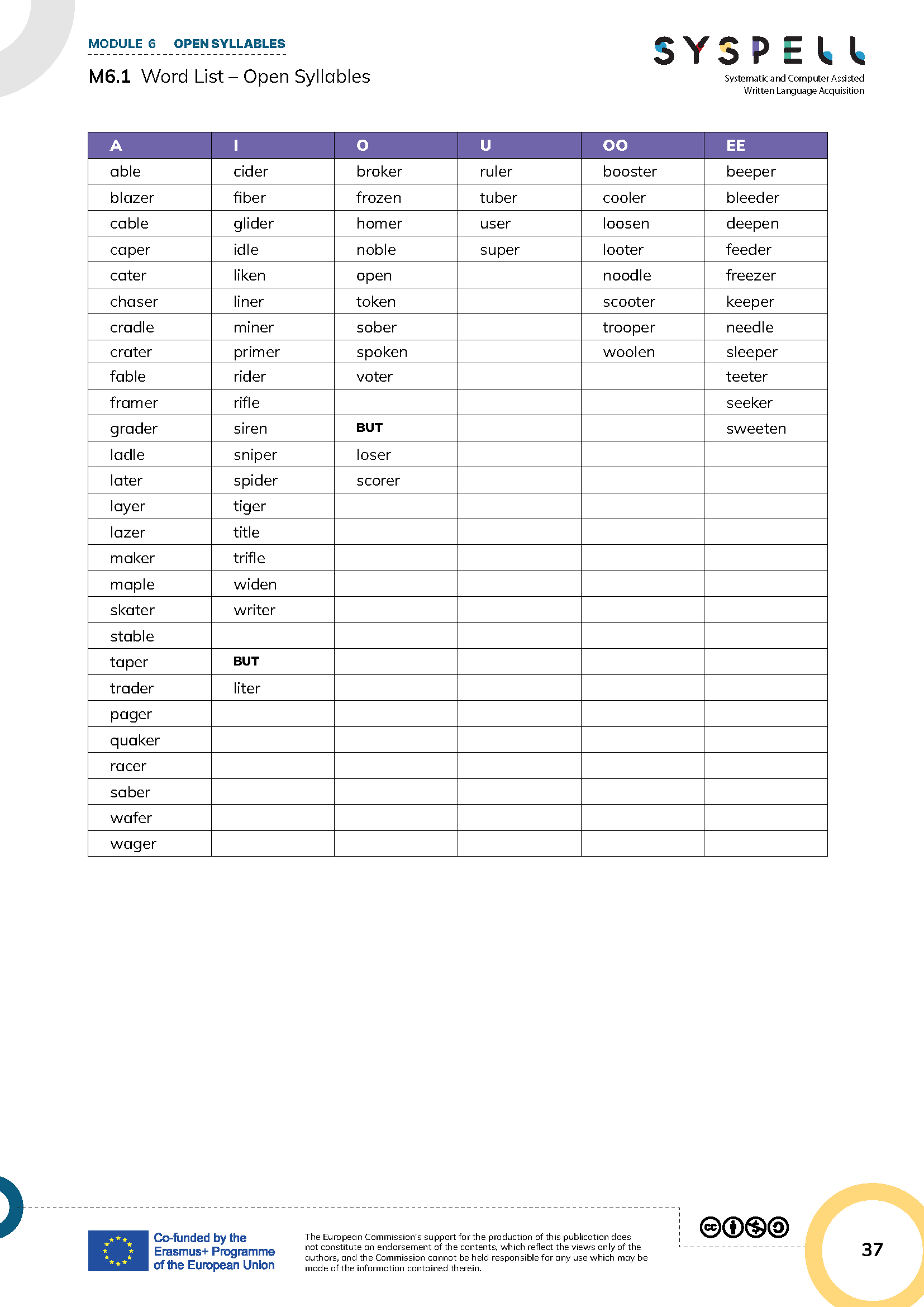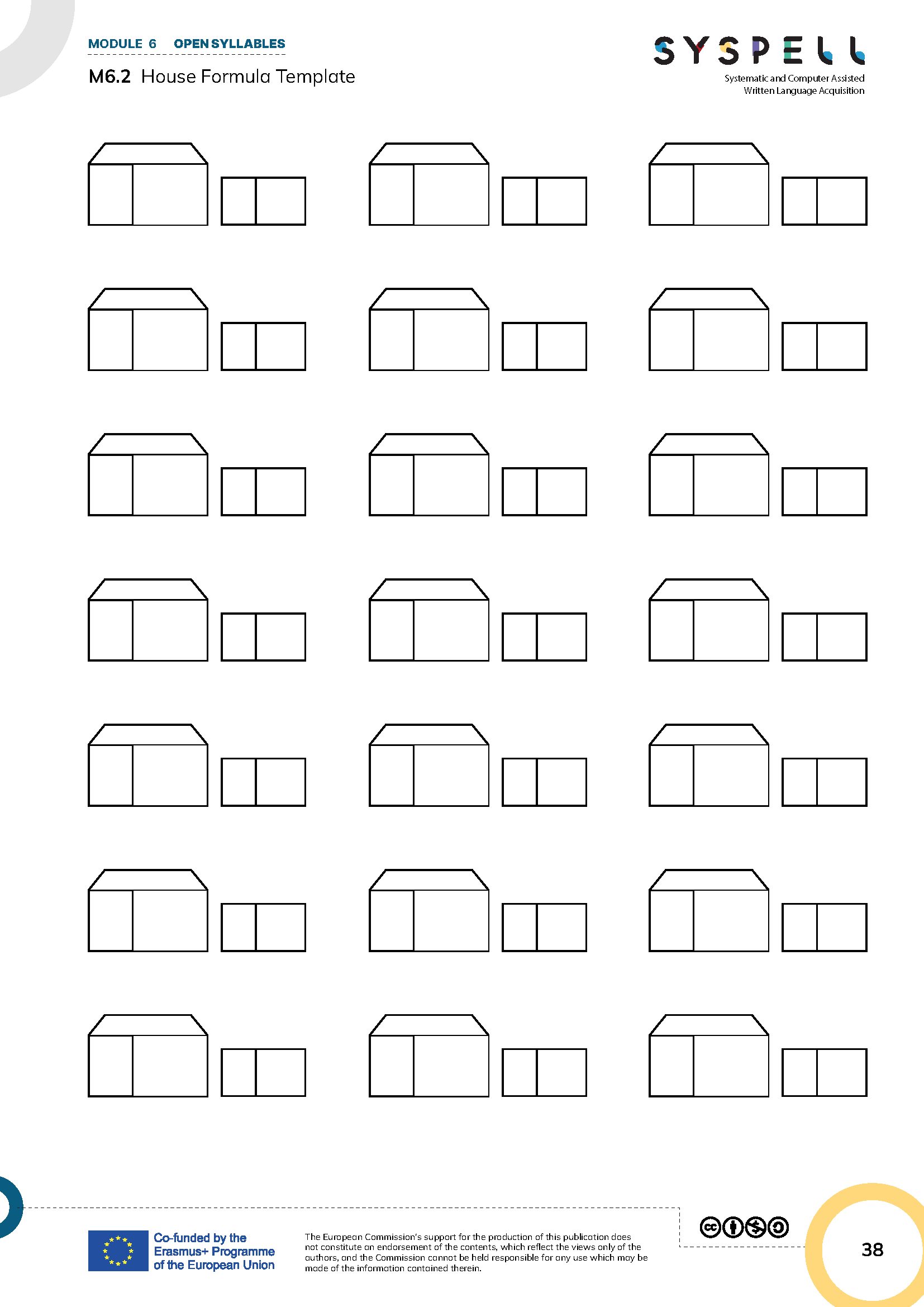Module 1 - Vowels & open syllables
Vowels
Most of the trochaic words in English which have a short vowel in the first, closed syllable have two consonant phonemes and letters at the boundary between the first and second syllables. One subset of such words end in phonemes /əl/ spelt <le> - so the schwa and /l/ seem to be spelt by <l> and <e> in the reverse order.
Objectives
The children recognise that (a) the vowels in closed heavy first syllables of trochaic words are short, coming from the set /æ e ɪ ɒ ʌ/ as in pat, pet, pit, pot, putt; (b) the first of the two consonant phonemes and letters at the syllable boundary belongs to the first syllable, and the second phoneme and letter belong to the second syllable.
Analysing closed syllable words in house formulas is a visualisation aid and supports the children’s perception.
The children are shown that this type of trochee can have other endings.
Materials
Blackboard or whiteboard
Chalk or marker (blue, red and green)
Materials of/for students:
Exercise books
Pens or pencils (blue, red and green)
Worksheets
Activities
Revision. Children call out words they identified in the homework exercise at the end of Module 3.
Introduction of closed syllable words - 4.1 WORD LIST – CLOSED SYLLABLES
In 4.1 WORD LIST – CLOSED SYLLABLES the children analyse words with closed syllables like <gamble>, preferably in rhyming sets, for example amble, gamble, ramble, scramble; fumble, grumble, humble, tumble. Teacher encourages them to recite the pairs rhythmically. The term ‘syllable bound- ary’ should be explained here.
Variations. The ‘gamble-set’ is then extended to trochees with other endings, e.g.
blender, lender, tender; drunken, sunken.
Exploration. The children should now make comparisons between the words and recognise the distinguishing detail for themselves:
gam - ble: I hear two different consonants and can easily separate the syllables, but the last two letters seem to be the wrong way round for the sounds.
ten – der, sun - ken: I hear two consonants and see two letters, one of each closing the first syllable and the others opening the second syllable.
Exercise before next lesson
Find as many words as you can which have the same pattern of trochees with closed syllables such as <gamble, drunken or sister>: One or more consonants at the start, a single vowel letter with a short sound, a two different consonant letter making two differentsoundsandtheendingin<le>,<er>or<en>.
open Syllables
split digraphs.
Teacher writes up a few words with M6.3 TROCHEES – SPLIT DIGRAPHS <a-e, e-e, i-e, o-e, u-e>, e.g. make, scene, like, rose, cute, rude. (<y-e> is too rare to bother with, and may cause confusion with <i-e> which has the same pronunciation.) Children attach appropriate suffixes to produce (for example) maker, liking, rosy, cuter, rudest, and are led to see that these words now conform to the rule that stressed open syllables in trochees have letter-name vowels spelt with name letters.
Teacher now explains why English has split digraphs. In Old English, as I modern German, these words had two syllables, e.g. rose was pronounced /ˡrozə/ just like Rose is now in German – but gradually the /ə/ at the end got fainter and fainter and then disappeared – but in words like this the vowel letter got pronounced like its name.
Open Syllables
Introduction
The words with this pattern have an open stressed first syllable containing a long vowel or diphthong, a single consonant phoneme belonging only to the second syllable at the syllable boundary, and a weak ending of the by now familiar type. Although the open syllable is the simplest form, this module is placed at the end of the sequence because, by this point, the children should already have good experience in the conscious auditory perception of their speech. and in the description of their observations.
In the open syllable, the vowel phoneme is particularly important. Where that phoneme is one of the letter-name vowels /eɪ iː aɪ əʊ ju ː/ (as in the alphabet), plus /u ː/, there is a strong tendency for those sounds to be spelt with the name letters <a e i o u>, with <u> covering both /ju ː/ and /u ː/. This tendency is especially strong for /əʊ/ and /ju ː/, where there are only tiny numbers of exceptions. It is weakest for /iː/ spelt <e>, where there are lots of exceptions.
Objectives
The children perceive the position of the vowel in the open syllable as particularly noteworthy. The house diagrams help them to understand this position better.
With the help of rhyming words, the children reinforce typical vowel spellings in trochaic words.
They can understand the phenomena of “split digraphs” as a variation of trochaic pattern.
They know how to look for minimal pairs from all word lists and can use them in (funny) sentences.
Materials
Blackboard or whiteboard
Chalk or marker (blue, red and green)
Materials of/for students:
Exercise books
Hand mirrors for the children
Pens or pencils (blue, red and green)
Paper cards, scissors, glue
Worksheets
As well as all previous word lists M3.1, M4.1, M5.1
Activities
Introduction. Auditory training of vowel qualities in open-syllable-trochees. The teacher gives different examples from M6.1 WORD LIST - OPEN SYLLABLE and invites the children to listen carefully to the sound of the vowels and to observe themselves (‘inner camera’ / hand mirror), the teacher and classmates. The children describe their perceptions and compare them with their previous experiences - the teacher writes different examples from the list on the board. The children discover that in these words the vowel is pronounced as in the alphabet.
In all phases in which children are to perceive patterns consciously, the description of their observations and experiences is an important learning step. In this phase, the children must be able to count on the full appreciation and acceptance of their statements.
Exercise. The words in the “open syllable” collection are arranged according to the stressed vowel. This automatically results in many rhyming words that help the children to memorise these categories.
The children write the words with their colours in the house formulas on their work- sheets M6.2 HOUSE FORMULA TEMPLATE . They also highlight the vowel by circling it in red.
All the words in the list have to be learned by heart, and reinforced by pairs of children taking turns to dictate words to each other.
With the words on the list (open trochees), the children work in partners to find more words that can be used according to this rule. They use paper cards, scissors and glue again and work in their notebooks. Some words on the list do not fit into this pattern (open, stolen,...).
Split Digraphs
M6.3 TROCHEES – SPLIT DIGRAPH
Teacher: We want to repeat what we have already learned about the split digraphs. Now you can understand even better – these words are spelt like trochees. The <e> in the end is the “trademark”. It helps us to understand the quality of the vowel. Let’s now work on some of these words! Write them into the little houses, write them into your exercise books and use your coloured pencils!
Teacher writes up a few words with split digraphs - see M6.3 TROCHEES – SPLIT DIGRAPH
<a-e, e-e, i-e, o-e, u-e>, e.g. make, scene, like, rose, cute, rude. (<y-e> is too rare to bother with, and may cause confusion with <i-e> which has the same pronunciation.)
Children attach appropriate suffixes to produce (for example) maker, liking, rosy, cuter, rudest, and are led to see that these words now conform to the rule that stressed open syllables in trochees have letter-name vowels spelt with name letters.
Teacher now explains why English has split digraphs. In Old English, as I modern German, these words had two syllables, e.g. rose was pronounced /ˡrozə/ just like Rose is now in German – but gradually the /ə/ at the end got fainter and fainter and then disappeared – but in words like this the vowel letter got pronounced like its name.
Teacher: We are now going to learn about a special kind of words called 'cvc + e words'.
First, let's break down what cvc + e means. 'cvc' stands for consonant-vowel-consonant. It means that we have three letters in a row, with the first letter being a consonant, the second letter being a vowel, and the third letter being another consonant. For example, 'cat' is a cvc word because it has the consonant 'c', the vowel 'a', and the consonant 't'.
Now, let's move on to the '+ e' part. The '+ e' means that we add an 'e' at the end of a cvc word to change its sound. This 'e' is very special because it works like a magic wand and transforms the vowel sound in the middle of the word.
For example, let's take the cvc word 'tap'. When we add the magic 'e' at the end, it becomes 'tape'. Do you see how the 'a' in 'tap' changes to a long 'a' sound in 'tape'? The 'e' makes the vowel say its own name!
We can find lots of other examples of cvc + e words. Let's try a few more:
'hop' + 'e' = 'hope' (The 'o' in 'hop' changes to a long 'o' sound in 'hope'.)
'win' + 'e' = 'wine' (The 'i' in 'win' changes to a long 'i' sound in 'wine'.)
'cup' + 'e' = 'cube' (The 'u' in 'cup' changes to a long 'u' sound in 'cube'.)
To help you remember cvc + e words, you can think of the 'e' at the end as a superhero cape that changes the vowel's sound and makes it say its own name!
Word Pair Rap. From the different word lists M3.1, M4.1, M5.1, the children look for minimal pairs, e.g. ‘ample – apple’ or ‘able – amble’ or ‘noble – nobble’, and form (preferably amusing sentences in which both words occur and which can be chant- ed. Some stretching of the spellings (and word length) should be allowed, e.g. ‘dazzle – damsel’ or ‘puzzle – ‘Rapunzel’. For examples see M6.4 WORD PAIRS RAP.
Advanced and curious children could be asked: Why are there so few such pairs? The most advanced could be asked: Can you find any other word triples like ‘gam- ble – gabble – gable’ with one word belonging to each of the trochee groups? [There could be a prize here.]
Exercise before next lesson
Find two-syllable words in which the letter-name vowels /eɪ iː aɪ əʊ (j)uː / are NOT
spelt <a e i o u>. Here’s one to start them off: ‘teacher’!
